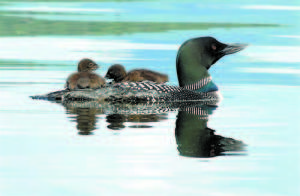Baby loon pleases many on Pleasant Lake

SPECTACULAR SIGHT — Although it is a spectacular sight seeing chicks with their mother, onlookers should keep their distance to avoid distressing the birds. (File Photo)
Calls of the Common loon
Yodel — Only the males do the yodel. This call is done when the loon is threatened and when the loon encounters other males during springtime mating season.
Tremolo — This sound is part of pair bonding. Also is used as stress call.
Hoot — This is a shorter, contact call between bonded pairs and family members.
Wail — This call is a longer, reverberating sound. It is used as a contact call between parents and chicks.
By Dawn De Busk
Staff Writer
CASCO — People who live around Pleasant Lake are protective of the recent hatchling from a pair of loons.
The loon chick, which is about three weeks old, is the first one to be documented on Pleasant Lake in 35 years.
“This year, we are enhanced by having a chick on Pleasant Lake. Never in 35 years have I seen one. It has been seen in the mornings and in the afternoons, with both parents and riding on the back of one of its parents,†said Peter Barber, Pleasant Lake and Parker Pond Association president. “This year, we are lucky. I hope it gets to adulthood. This would be a chance to see the pair mate and raise a chick again next year.â€
He urged people to look at the chick using binocular lenses, and keeping a distance so as not to distress the loon family.
On Saturday, the lakes association held its annual meeting. The guest speaker was wildlife biologist Susan Gall, who is the director of the Protect the Loon project for the Maine Audubon Society.
Specifically, common loons were the topic of conversation. Gallo provided basic information about this species of loon found in Maine as well as some surprising facts. Also, she shared new legislation that will ban the sale and use of lead sinkers that are one ounce or smaller. Additionally, she supplied free tin sinkers and tin jiggers.
The common loon spends seven years on saltwater marsh, and then, returns to its lake of origin.
Gallo said many lakefront property owners assume that the pair of loons they see every summer stays together for 20 years or longer. Association members were most surprised to hear that loons pair up for about seven years.
“I was devastated to hear that they didn’t mate for life,†an audience member said. “I thought it was the same pair on the lake for 25 years. We named them Frankie and Johnny. I didn’t know one year maybe it was Jane and Johnny.â€
For the loon, spring is courting season.
Prior to ice out, the male loons begin doing flyovers of the lakes, according to Gallo. As soon as open water is available, the loons move into their territories.
“In the week or two before they show up here, they are flying overhead, cruising by and checking it out. From the ocean to here is about an hour or so away. They keep checking out what is open — where the ice is gone,†Gallo said. “Territories are limited in Maine. Finding breeding space is really important to the loon.â€
The ideal territory for a pair of loons is a lake with 100 to 200 acres. A family of loons can eat as much as 1,000 pounds of fish so it needs a sizable body of water. Under those conditions, a pair of loons will be most successful with nesting and raising young.
On larger lakes, the territory might be split between different families of loons.
“They need something to delineate the lake, a physical terrain, like a cove,†Gallo said. “The loons have to monitor their boundaries and spend time working with their neighbors.â€
In addition to territory that encompasses a whole lake or a section of a lake, some loons nest on multiple lakes – in order to catch enough fish to survive. However, birds that have this housing arrangement tend to have the least success in raising chicks, Gallo said.
The Maine Audubon does it annual loon count — with the help of thousands of volunteer scientists — on the third Saturday in July. This weekend’s count will mark the 30th year that the Maine Audubon has collected this data. The loon count will take place from 7 a.m. to 7:30 a.m.
According to the Audubon’s website, “This early-morning time provides an excellent snapshot of Maine’s loon population.â€
As far as the mortality rate of loon chicks, it can range drastically from year to year.
“With loon chicks, the count goes up and down from year to year. We cannot make rhyme or reason of why,†she said.
Even before they hatch from their eggs, the baby loons face many predators including bald eagles, raccoons, mink, and domestic dogs.
The loon eggs have a 28-day incubation period, and both parents take turns sitting on the nest. A video recorder captured a nesting pair, and revealed that the female takes the nighttime shift while the male cares for the egg during the day, Gallo said.
Sometimes, new hatchings fall prey to big fish or snapper turtles as well as bald eagles, Gallo said.
The Maine Audubon does collect the bodies of dead adult loons to determine the most probable cause of death.
“Big boats can cause blunt trauma,†Gallo said, adding that canoes and kayaks can also disturb the nest.
Another thing that contributes to the death of loons is lead sinkers and lead-based fishing tackle.
The loon ingests the sinkers along with gravel on the bottom of lakes. Because loons have an acidic gizzard, the lead gets into the system quickly and they die within a few weeks, Gallo said.
The Audubon Society has worked with bass fishermen to create a tackle exchange program. As of September 2013, it will be illegal to use lead sinkers that are one-ounce or smaller. In 2016, the sale and use of lead jiggers will be banned.
Gallo said this legislation is a step in the right direction — toward protecting the loon; and loon conservation is in the hands of the inhabitants in the lakes region.
“Bald eagles won’t be end of loons in Maine. Fireworks won’t be the end of loons in Maine. Lead sinkers won’t be end of loons in Maine,†Gallo said.
But, people can help to protect loons by slowing down their boats, watching out for chicks, and switching to non-lead fishing tackle, she said.

